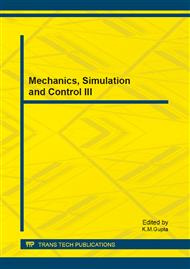p.270
p.275
p.280
p.286
p.292
p.297
p.302
p.308
p.312
Study on Plant Water Stress Based on Ultrasonic Acoustic Emissions
Abstract:
The soil water deficit and strong transpiration can give rise to the phenomenon of plant water stress. Because of the water stress produces the fracture of the water column in conduits, and the fracture is the reflection of energy release which can be detected by the ultrasonic acoustic emissions (UAEs) technology. In order to avoid background noise interference, the UAEs detecting frequency is between 100K Hz and 1 MHz. The PCI-2 data acquisition (DAQ) card and R15 sensors are used to improve the precision of UAEs detection. When the water stress and dehydration gets heavier, the UAEs get higher. Use the tomato plant data with the empirical deduction under the modern greenhouse conditions, the relationships among UAEs, transpiration and UAEs signal strength is described by curve. The UAEs signals occur generally from 5:00~7:00 am, and stop after 20:00 at night. In the daytime, when the plant body water storage is few, and transpiration is strong, the UAEs occur two peaks, called the “Twin Peaks Area” (TPA). In the different conditions of soil water content status and environmental factors, the TPA occur time will be advance or lag, which is generally in the range of 8:00~15:00. An acoustic emission event maybe produces several UAEs counts, while the UAEs counts have a correspondence with the UAEs signal strength. It is better to use UAEs technique to diagnose the plant water status and carry out automatic and precise irrigation for the plant and to improve the effect of Water-saving irrigation.
Info:
Periodical:
Pages:
292-296
Citation:
Online since:
August 2013
Authors:
Keywords:
Price:
Сopyright:
© 2013 Trans Tech Publications Ltd. All Rights Reserved
Share:
Citation:


